I’ve been studying the eight function model for many years and recently finished Jung’s work on Aion and cognitive functions. In this article, I’m going to add to the theory by Beebe and Jung and show how it can be made more useful. One of the most important changes? I connected it to Joseph Campbell and the Hero’s Journey.
What I like about Beebe and the Eight Function Model is it’s connection between the cognitive functions and archetypes. Beebe’s argument, and I agree with this, is that every personality type has a unique relationship to the cognitive functions, and that this relationship can be defined through the use of archetypes. However, I have three key critiques against his work.
In this article, I’ll be explaining that critique and also presenting a workable alternative. I have already tested this theory and discussed it extensively with other people in the community and so far, I have gotten a great response. I believe this is the starting point of a new direction in the debate.

Three Criticisms Against The Eight Function Model
An Overly Pessimistic View On The Human Psyche
First of all, while the relationship of the 1st and 4th function is well understood, the initial terminology and the archetypes connected to the lower 4 functions is described in a very negative, demonizing way. Beebe is painting the picture that the unconscious is the root of evil, and attributes the witch, trickster, and archetypal demon to the unconscious four functions.
I believe nothing in our psyche is inherently evil. What makes a function evil is our relationship to it, alongside our stressors and anxieties, and past traumas. The way we view the psyche and the cognitive functions, and our mindset, says more about our development, than the way the human mind actually works.
I’m a Humanitarian and by that, I believe that good means to be human, and that is the definition we should be working with. What we should be advocating is the goal of individuation, and the capability for people to embody and practise humanity, and their core values, and interests, in harmony with the values of other people. So In my alternative to the Eight Function Model, I show how each cognitive function can take a positive role, so that we can begin to nurture a positive relationship to our thoughts and feelings, instead of repressing or avoiding parts of it.
A Sad Misunderstanding About Consciousness
Another problem is the order of the eight functions. A sad takeaway from the Eight Function Model is that your cognitive functions can be described to which degree they manifest consciously. Your cognitive functions are simply what thought patterns you engage in the most often.
I have found that this is not the case. Every function manifests in us and we use all eight cognitive functions. Each personality type has a unique relationship to each of the eight cognitive functions. Still, today, I see a lot of people handing out charts stating that we use the dominant function 80% of the time, the auxiliary 60% of the time, the tertiary 40% of the time, and so on.
Lack of practical use or purpose
So far, attempts to form a workable theory of how to use and understand the archetypes and cognitive functions for personal growth has not been successful. There are many definitions and theories on what the cognitive functions are, but little workable, practical advice on how you should develop and learn to use the eight cognitive functions.
Some general theories have formed, such as the theory about Looping, being in the grip of the inferior, anima/animus struggles, struggles with the Trickster function, and similar. But no clear or decisive model exists. We are still stuck in the descriptive stages, where we are trying to define what things are, and not yet ready for the functional approach, of why and how to use the cognitive functions for personal growth and flow. My goal is to connect the study of personality types to the study of flow and well-being.
The Hero’s Journey and the Eight Cognitive Functions
The solution I arrived to was the following:
- Connecting the Eight Function Model to the Hero’s Journey, and showing clearly in what order, and how, we need to learn to relate to all eight of the cognitive functions.
The Hero’s Journey was formulated by Joseph Campbell when he studied the hero myth and traditional storytelling. He found in the hero’s journey that all stories had a similar structure. The structure, i believe, is not too different from the process of individuation. It’s a map of the experiences we go through and how we learn to relate to all of the eight cognitive functions.
- 2. Connecting the Eight Function Model to the study of flow
First, the dominant function is explained by its relationship to the feeling of flow. It is directly connected to our sense of agency and power. If we don’t develop the dominant function, we risk falling into a state of autopilot, under the influence of the 8th function, or we become so focused on our persona or presenting a pleasant image to the outer world, that we have no time to enjoy the life we live. Or we are so focused on chasing after what’s next, chasing fickle inspiration, and forgetting to maintain our balance and well-being.
- 3. Defining the relationship between each cognitive function, to each cognitive function.
Intuition, Sensing, Feeling and Thinking represent values and interests. Introversion and Extroversion define attitudes and temperament of the person that is pursuing said values and interests, and what is comfortable for each person. The rules that I have observed are as follows:
The Cognitive Functions and Their Archetypes

How To Develop A Positive Relationship to Each of the Cognitive Functions
You want to nurture and maintain the flow function as much as possible, without neglecting important duties and responsibilities. Think about how to create a life where you can do what you love as often as possible, and learn to ask for help and reorganise your environment so that you don’t have to engage too often in your stressors.
Use the goal function to set realistic and positive goals for yourself to improve at, and maintain a good sense of humor. Don’t be too hard on yourself if you fail, and learn to laugh at mistakes and mishaps. People who have a good grasp of the auxiliary have a high playfulness.
Use the hobby function as a way of parallel play with the dominant function. Use it to help you excel and polish your dominant attitude and to bring out the extra flavour in your core process. Avoid using it to run away from responsibilities or to distract yourself from what you know is the right decision.
Use the inferior function to protect you from harm and difficulties, and to maintain a good standing with other people, but never let your persona grow to the extent where you can’t be real or honest with other people. Allow yourself to be vulnerable with other people, and share your real feelings and thoughts, and don’t try too hard to put on a strong front.
Use the inspirational function as a fuel or extra motivation. Nurture courage and bravery so that you can engage in this function even if it is scary or difficult.
Nurture hope and optimism and trust so that you can engage in the Utopian function. Use it to gain genuine relief and to reward your positive behaviour, and to celebrate and enjoy the roses of your work.
Use the aggressive function when you need to stand up for yourself or voice important beliefs or push for something that is important to you, but don’t let it take you over or make you do something reckless or harmful to yourself or others.
Learn to use the control function to manage boring and annoying tasks in an automatic, reflexive way, that doesn’t overwrite or damage the progress you are making or without falling in the grip of the autopilot.
Want to learn about the functions for the different 16 personalities? Check out these images to see how it works for your personality type!
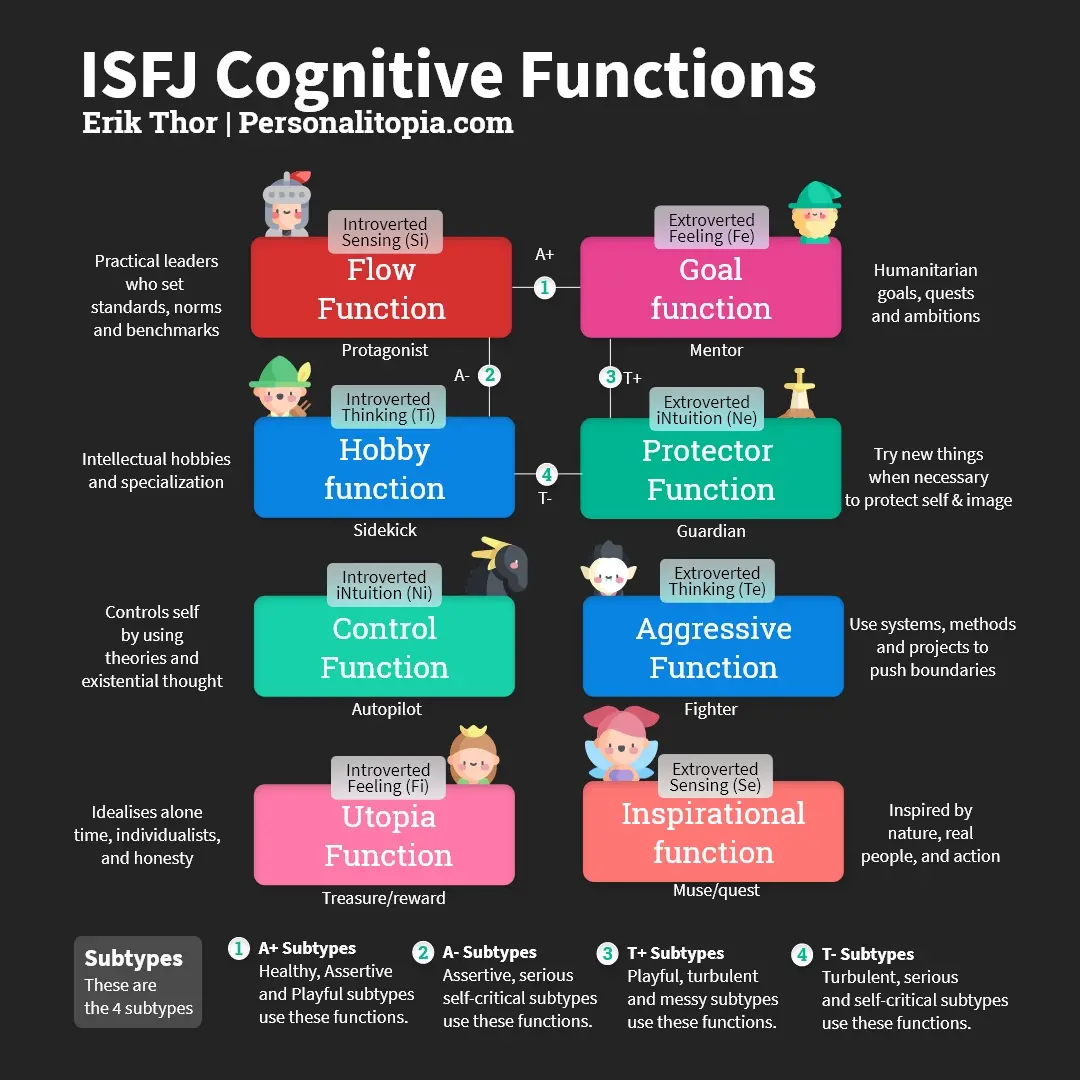




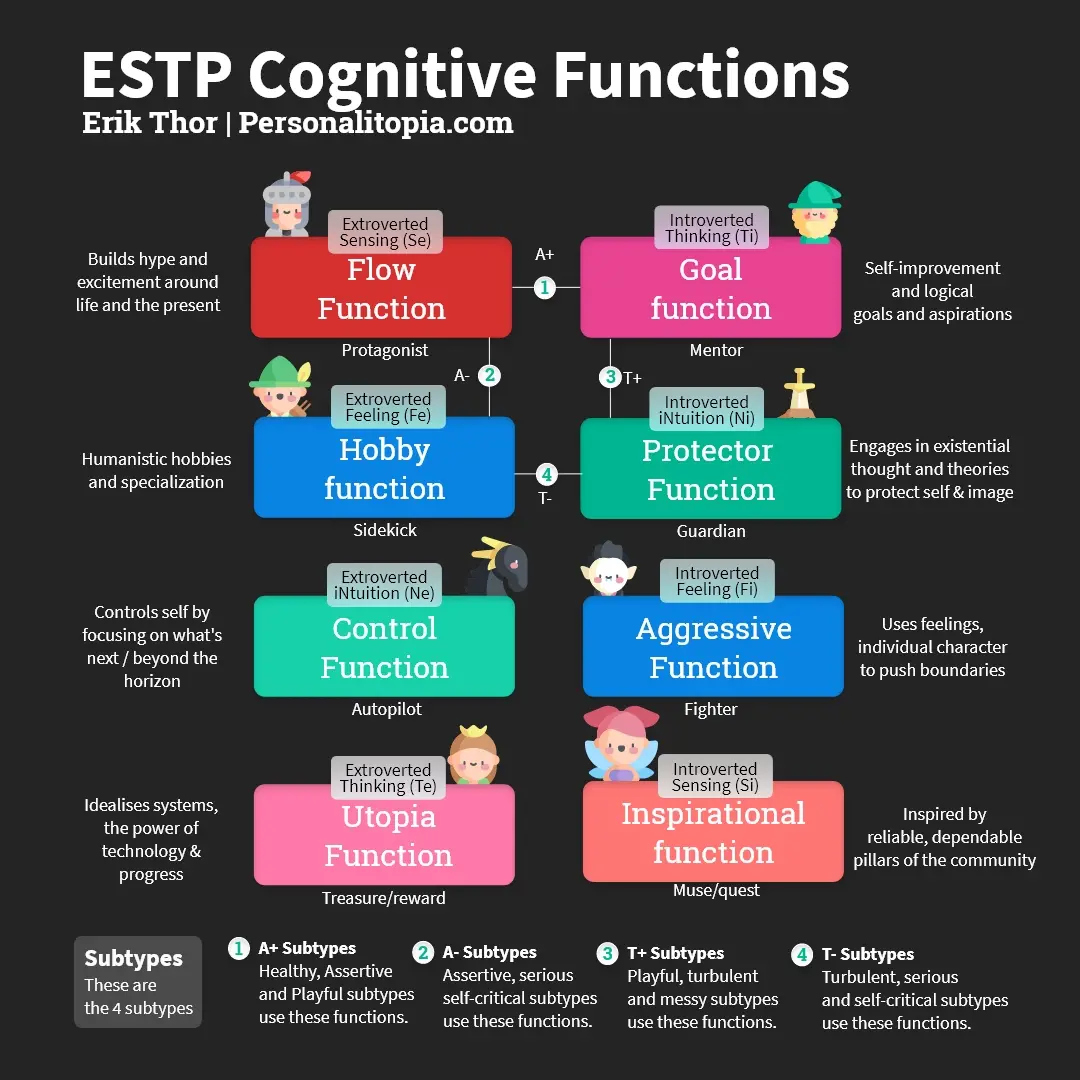



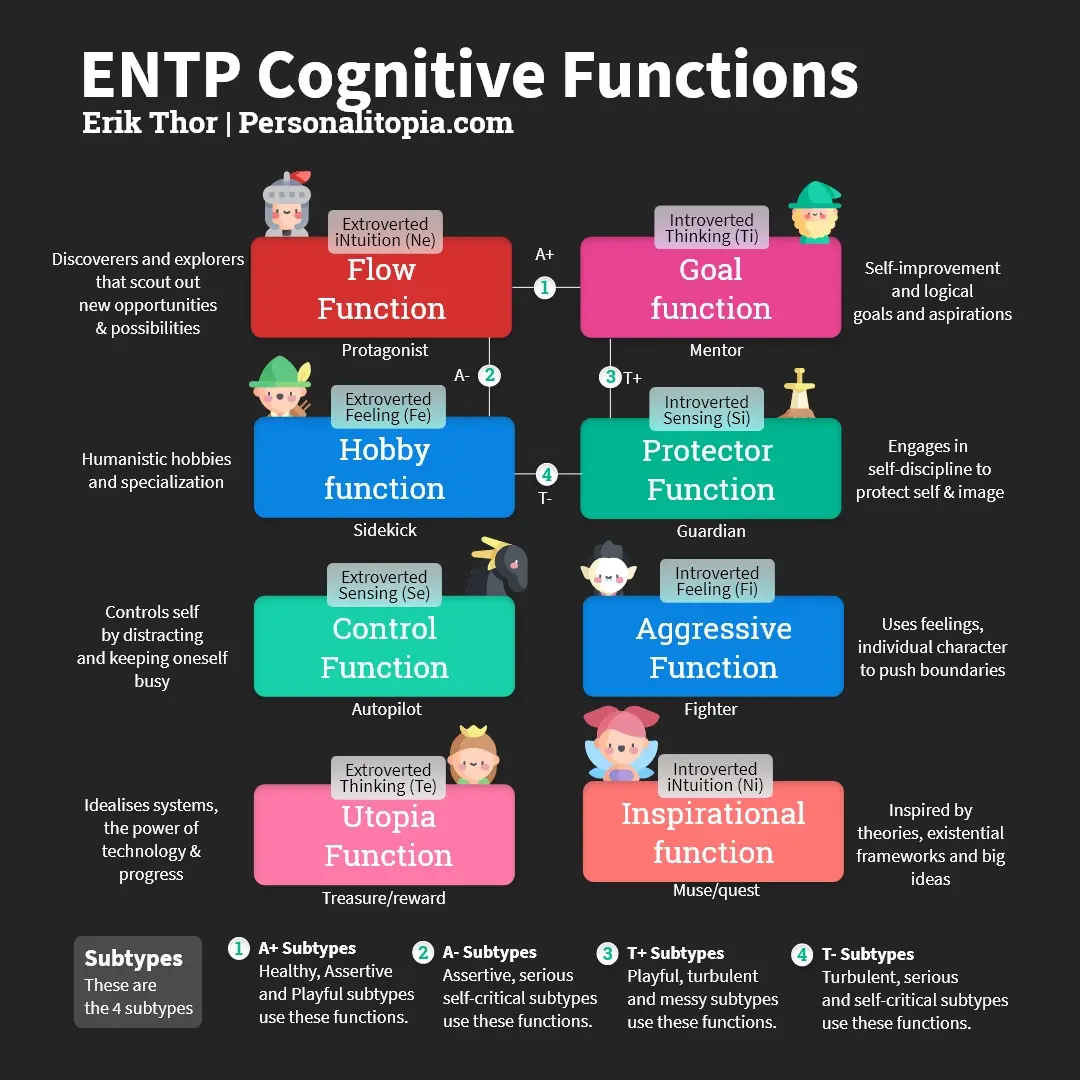
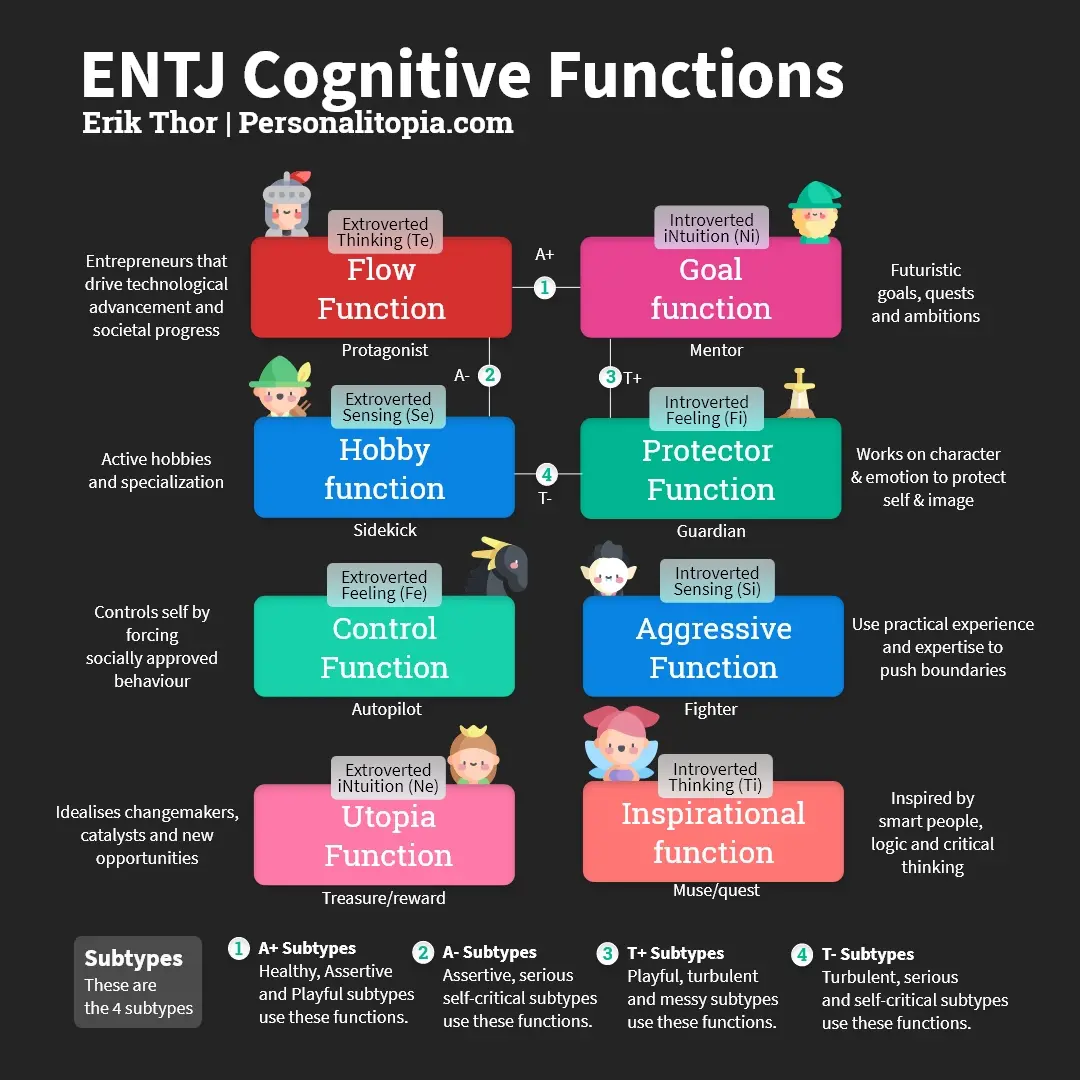
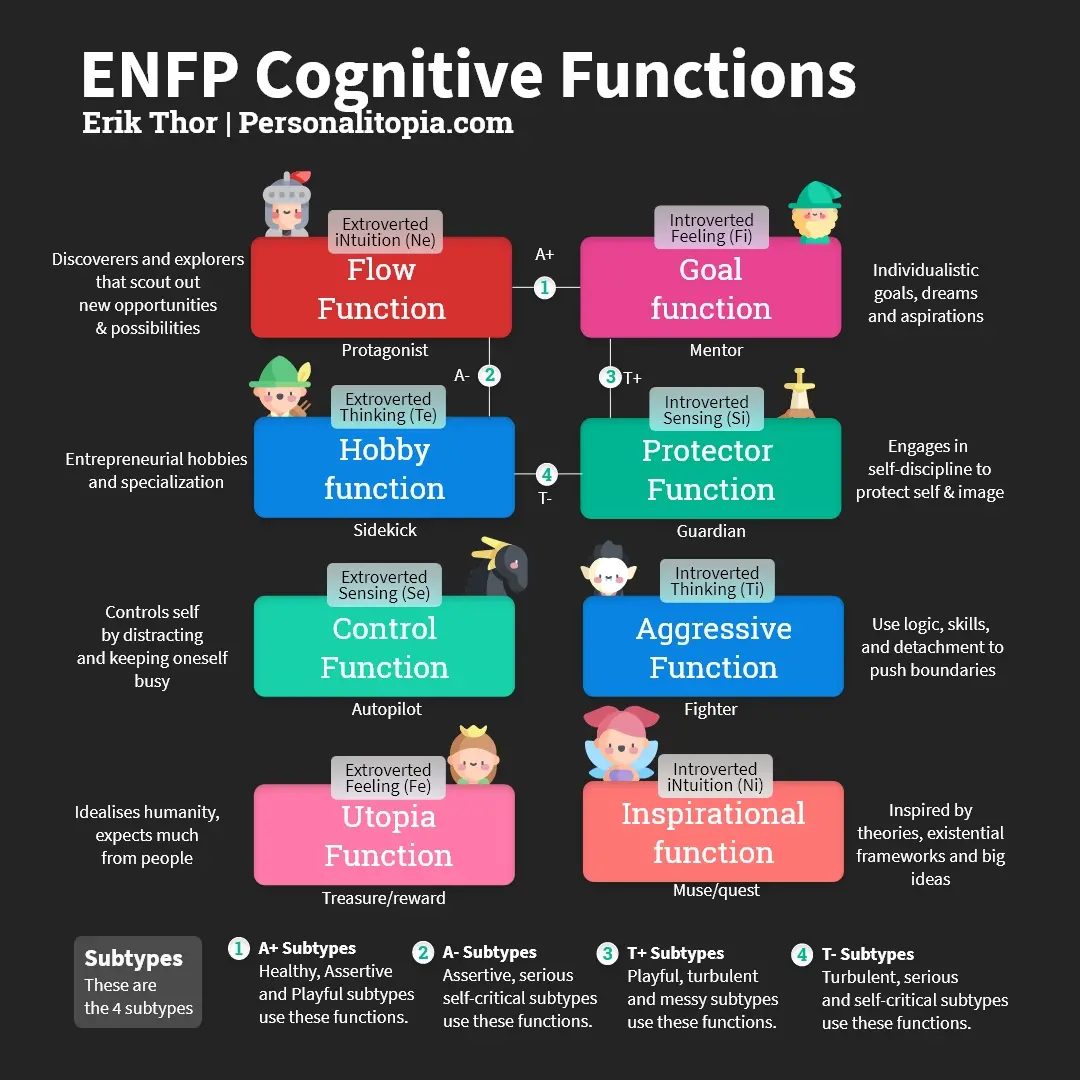




The Eight Rules of The Eight Function Model
Firstly, introverted and extroverted attitude of each value or interest has the relationship of an engine to its primary fuel source, for example in the relationship between introverted intuition to extroverted intuition. Both functions feed of each others, one serving as the source of fuel, and one as the engine, and the relationship between these functions is mirrored. That means, both perceive the experience in a similar way, as revitalising, energising, and recharging.
Secondly, two functions of the same attitude, but opposing values, tend to have a calming and supportive effect on one another, serving as a relief or helping one another relax. However, when one takes over, the other is numbed or disconnected, causing us to lose conscious awareness of it and its influence. The experience or relationship can be defined as two painters trying to draw on the same canvas at the same time. They will inevitably draw over and erase the work of one another.
Thirdly, two functions of opposing attitudes, and opposing values, tend to have the relationship of putting water on fire, in that they are transformative, when they come into contact with one another, both are transformed. There is always a tension between these energies, as Jung would describe it, and the result is an immense psychic energy. These are in conflict with one another, but it is a positive conflict, in which both are transformed. Typically, the interplay of these functions can drive growth, but if the inferior topples the dominant, the result is a crash in energy.

